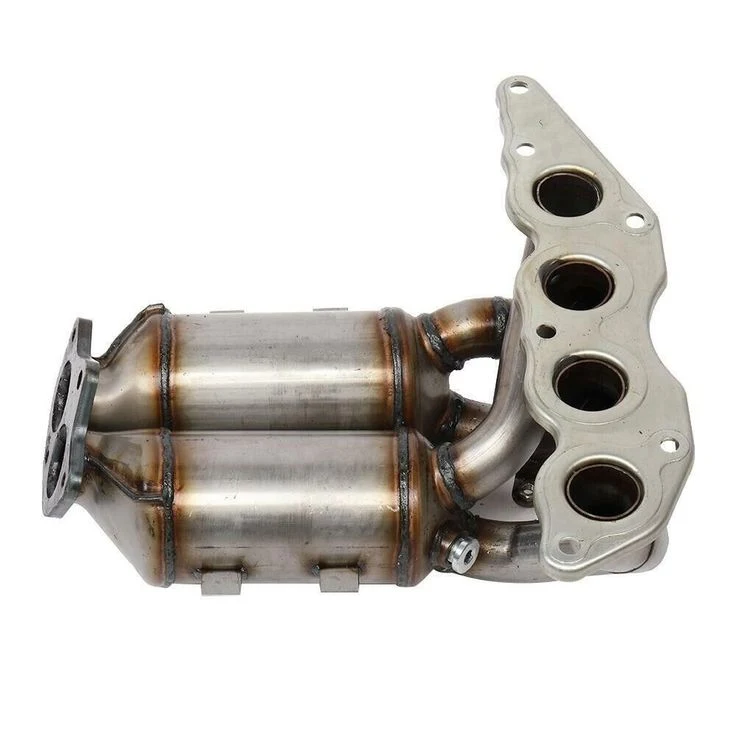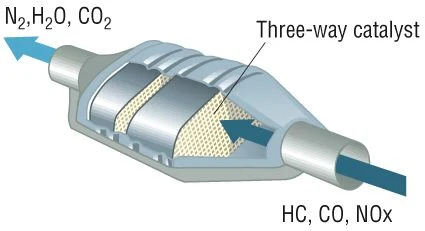catalytic converter / what is a catalytic converter
🛑 Introduction :-
Catalytic converters (CAT) are designed to convert hazardous combustion engine gases into harmless gases through chemical reactions and therefore the catalytic converter is an integral part of modern carbon dioxide treatment systems for both SI and diesel engines.
🛑 Function Of Catalytic converters :-
Catalytic converters (CAT) are designed to show harmful components of exhaust emitted through internal combustion engines into innocent gases by a chemical reaction.
🛑 Construction Of Catalytic converters :-
The catalytic converter is composed of the following components.
- Submetal :-
A core made of clay honeycomb or metal plates
- Washable coat :-
Material made of aluminum oxide, titanium dioxide, silicon dioxide, silica, or alumina
- Catalyst :-
Coated with platinum, palladium, or rhodium
- Accommodation :-
Honeycomb in the room
The honeycomb structure of the substrate provides a large surface area for the catalyst to interact with the exhaust gas. The catalysts work with the resulting gas to reduce toxic pollutants into more harmful compounds such as carbon dioxide and water vapour.
Catalytic converters are used in automotive exhaust systems to reduce the amount of toxic pollutants in the air. It is used in electric motors, forklifts, mining equipment, trucks, buses, trains, motorcycles and ships.
🛑 Working Of Catalytic converters :-
- The three stages of a catalytic converter are shown in Figure 6.10. The conversion rate of a catalytic converter is largely determined by operating temperature; The reduction in sewage treatment does not occur until the converter becomes 400… 800°C provides ideal conditions for extended performance and extended life.
- The catalytic converter operates at its optimum conversion efficiency with lambda = 0.99 to 1. (= excess air factor, actual air supply/theoretical air demand).
🛑 Structure of catalytic converters :-
A catalytic converter includes a stainless steel casing that homes a steel (megalith) or ceramic (monolith) substrate. This substrate has a completely massive variety of pleasant channels going for walks through it alongside its period. The purpose here is to create the best feasible floor vicinity to optimize the catalytic effect. The floor of the substrate is coated with a exceedingly porous layer (wash coat) to which valuable metals (platinum, palladium and/or rhodium) are delivered in suspension. It is those treasured metals which might be the real catalysts starting up the chemical reactions required to purity the exhaust gases.
🛑 Different types of catalytic converters :-
1). EOBD :-
Euro 3 and Euro 4 vehicles that are replaced Euro 3 and Euro 4 vehicles with European on-board diagnostics (EOBD) are referred to as EOBD-capable electronic on-board diagnostics are mainly found on in modern cars. This function monitors all emission-related measures and sensors while the vehicle is on the road. It records any faults and alerts the driver, for example, with an indicator light (MIL). Typically, the latest generation of diesel vehicles is equipped with an EOBD function.
2). Oxidation reactions :-
Diesel engines typically operate with a large amount of excess air, producing a large amount of oxygen in the exhaust. Catalytic converters in diesel engines oxidize
And from carbon monoxide (CO) to carbon dioxide (CO2).
hydrocarbons (HC) to carbon dioxide (CO2) and water vapor (H2O).
3). Three way Catalytic Converter :-
The three-way catalytic converter is designed for SI engines.
Heat fluctuations during operation when CO2 in unburned hydrocarbons (HC) and carbon monoxide (CO) and carbon dioxide (CO2) in water vapor (H2O).
Nitric/nitrogen oxides (NO/NO2) form nitrogen (N2) and oxygen (O2).
These processes occur simultaneously in CAT, which is why it is called a three-way catalytic converter.
A three-way catalytic converter relies on
A specific exhaust gas composition to be Fully efficient. The process must release sufficient amounts of oxygen as necessary for the oxidation of hydrocarbons and carbon monoxide. This occurs when one part of fuel is mixed with 14.7 parts of air and then burned in an engine. Here we are talking about a stoichiometric mixture (lambda = 1). Residual oxygen in the exhaust gas to form this mixture.
🛑 Safety :-
For catalytic converters made of ceramic one-piece, mats are used to keep the substrate in place. The catalytic converter is shock protected and the secondary exhaust valve is covered. so far
Older microceramic fibers are used here but were widely suspected of causing cancer. Then the "green mat" was introduced to make the environment more harmonious. Green fabrics are not breathable due to their soluble fibers (which readily dissolve in body fluids without causing any damage to the organism) or their size.
🛑 Environmental protection :-
Modern post-disposal treatment systems contribute significantly to significant advances in the protection of human health. Engine combustion produces not only the primary components of water (H2O), carbon dioxide (CO2) and nitrogen (N2), but also harmful compounds.
Carbon Monoxide (CO) Hydrocarbons (HC) .
Nitrogen oxides (NOX) Sulfur dioxide (SO2).
As national and international emission and pollution regulations become increasingly stringent, they require not only new quality engine design but also complex exhaust systems is followed by use, which is required to achieve the specified threshold values A technically optimized converter, which puts the vehicle in a higher emission category and a tax benefit to the vehicle owner If it occurs that, he will increase the resale value of your car.
🛑 The fall in prices :-
Catalytic converters are based on natural growth. This is due to high temperatures (sometimes over 800 °C) and mechanical stresses (vibrations) during normal vehicle operation. This can cause the precious metal coating on the substrate to wear away over time. The average life of modern catalytic converters is between 80,000 and 100,000 km.
In addition to dipping in the CAT when driving over high obstacles, the following factors can also cause premature aging of the converter.
🛑 aggravating pollutants :-
If the engine burns too much oil, the additives can deposit on the surface of the catalytic converter, thus clogging it in. This prevents exhaust gases from reaching precious metals, which means the catalytic converter cannot produce works well.
Catalytic contamination can also occur if you frequent short trips. In this case, however, the CAT can usually be regenerated by a long trip down the motorway.
Filling up with leaded fuel was once a common risk of contamination, but today this is only possible if you are overseas. Be especially careful when overseas and make sure you only fill up with unleaded (unleaded, sans lead) gasoline.
- Melting of the catalytic substrate :-
Due to faults in the ignition or fuel management system, the unburned air-fuel mixture finds its way into the catalytic converter and burns on the surface of the CAT This can cause the CAT temperature to exceed 1000 °C, and thus damaged substrate . Therefore, if you notice any fault with the ignition or fuel management system, you should go to the garage immediately.
Other Topics :-
electric vehicle brands / Challenges of electric vehicles.
🛑 People Also Ask :-
1) What is the purpose of a catalytic converter?
The main purpose of a catalytic converter
The catalytic converter is designed to improve the efficiency of your car’s engine. It does this by effectively removing nitrous oxide and carbon monoxide from the atmosphere by reducing harmful gases.
2) Does a car run without a catalytic converter?
Faced with the cost of the stolen “cat,” many consumers wonder, “Can I drive without my catalytic converter?” The answer is yes and no. Technically, the car can operate without a catalytic converter. But this is not a long-term strategy.
3) Why is catalytic converter so valuable?
Thieves often steal catalysts, in order to take advantage of the precious metals they contain. Catalytic converters are parts that use precious metals such as platinum, palladium and rhodium. This metal is valuable in the scrap metal market due to its high price.
4) Does a car run without a catalytic converter?
Faced with the cost of the stolen “cat,” many consumers wonder, “Can I drive without my catalytic converter?” The answer is yes and no. Technically, the car can operate without a catalytic converter. But this is not a long-term strategy.
5) Is catalytic converter good or bad?
And while the primary function of a catalytic converter is to reduce emissions, it also improves the efficiency of your vehicle. A well-maintained vehicle will extend the life of your catalytic converter, reducing the likelihood of expensive catalytic converter repairs or replacement.






Comments
Post a Comment